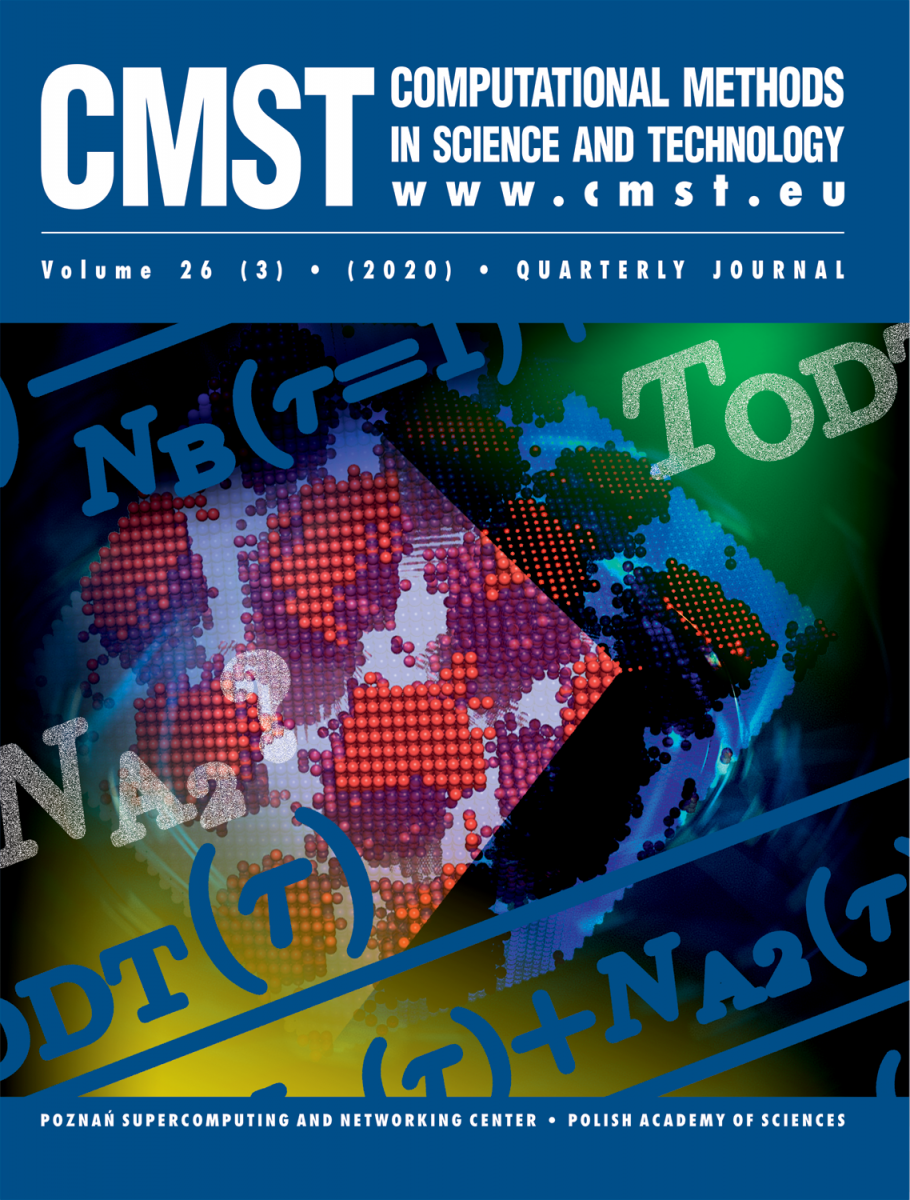Lyapunov Instability in Cell Models With and Without Time-Reversible Heat Transfer
Hoover William G. 1, Hoover Carol G. 2
2870 Ruby Vista Drive, Unit 109
Elko, Nevada 89801, USA
1 E-mail: hooverwilliam@yahoo.com
2 E-mail: hoover1carol@yahoo.com
Received:
Received: 31 December 2024; accepted: 22 January 2025; published online: 9 March 2025
DOI: 10.12921/cmst.2024.0000025
Abstract:
Two-temperature pedagogical cell models, extensions of the equilibrium Einstein model of solid state physics, can allow nonequilibrium hot-to-cold heat transfer. These heat-flow models can be driven by thermostatted temperature differences, for instance between horizontal and vertical degrees of freedom. We present pedagogical benchmark Lyapunov exponents for four equilibrium cell models: isoenergetic Hamiltonian, constrained Isokinetic, and two Isothermal Nosé-Hoover models. We also compute representative Lyapunov exponents for two members of a family of two-temperature dissipative Nosé-Hoover cell models. Further exploration of such dissipative models is the subject of the 2024–2025 $1000 Snook Prize.
Key words:
cell model, fractals, heat transfer, Lyapunov exponents, Snook Prize, time reversibility, λ
References:
[1] B.J. Alder, T.E. Wainwright, Molecular Motions, Scientific American 201(4), 113–126 (1959).
[2] B.J. Alder, W.G. Hoover, T.E. Wainwright, Cooperative Motion of Hard Disks Leading to Melting, Physical Review Letters 11, 241–243 (1963).
[3] S. Nosé, A Unified Formulation of the Constant Temperature Molecular Dynamics Methods, The Journal of Chemical Physics 81, 511–519 (1984).
[4] S. Nosé, A Molecular Dynamics Method for Simulations in the Canonical Ensemble, Molecular Physics 52, 255–268 (1984).
[5] Wm.G. Hoover, Canonical Dynamics. Equilibrium Phase-Space Distributions, Physical Review A 31, 1695–1697 (1985).
[6] Wm.G. Hoover, C.G. Hoover, Comparison of Very Smooth Cell-Model Trajectories Using Five Symplectic and Two Runge-Kutta Integrators, Computational Methods in Science and Technology 21, 109–116 (2015).
[7] W.G. Hoover, H.A. Posch, B.L. Holian, M.J. Gillan, M. Mareschal, C. Massobrio, Dissipative Irreversibility from Nosé’s Reversible Mechanics, Molecular Simulation 1, 79–86 (1987).
[8] B.L. Holian, W.G. Hoover, H.A. Posch, Resolution of Loschmidt’s Paradox: The Origin of Irreversible Behavior in Reversible Atomistic Dynamics, Physical Review Letters 59, 10–13 (1987).
[9] I. Shimada, T. Nagashima, A Numerical Approach to Ergodic Problem of Dissipative Dynamical Systems, Progress of Theoretical Physics 61, 1605–1616 (1979).
[10] G. Benettin, L. Galgani, A. Giorgilli, J.M. Strelcyn, Lyapunov Characteristic Exponents for Smooth Dynamical Systems and for Hamiltonian Systems; a Method for Computing All of Them. Part 1: Theory, Meccanica 15, 9–20 (1980).
[11] H.A. Posch, W.G. Hoover, Chaotic Dynamics in Dense Fluids, [In:] Proceedings of the Physics of Fluids Conference at Calabria, Lawrence Livermore National Laboratory Report UCRL–97344 – DE88 002453, Italy (1987).
[12] W.G. Hoover, E. Craig, H.A. Posch, B.L. Holian, C.G. Hoover, Heat Transfer Between Two Degrees of Freedom, Chaos 1, 343–345 (1991).
[13] W.G. Hoover, H.A. Posch, L.W. Campbell, Thermal Heat Reservoirs via Gauss’ Priinciple of Least Constraint; Dissipation, Chaos, and Phase-Space Dimensionality Loss in One-Dimensional Chains, Chaos 1, 325–332 (1993).
[14] J. Kaplan, J. Yorke, Chaotic Behaviour of Multidimensional Difference Equations, [In:] Differential Equations and the Approximation of Fixed Points, Lecture Notes in Mathematics 730, 228, Eds. H.O. Peitgen, H.O. Walther, Springer-Verlag, Berlin (2006).
[15] K.W. Wojciechowski, P. Pieran´ski, J. Malecki, A Hard-Disk System in a Narrow Box. 1. Thermodynamic Properties, Journal of Chemical Physics 76, 8170–8175 (1982).
Two-temperature pedagogical cell models, extensions of the equilibrium Einstein model of solid state physics, can allow nonequilibrium hot-to-cold heat transfer. These heat-flow models can be driven by thermostatted temperature differences, for instance between horizontal and vertical degrees of freedom. We present pedagogical benchmark Lyapunov exponents for four equilibrium cell models: isoenergetic Hamiltonian, constrained Isokinetic, and two Isothermal Nosé-Hoover models. We also compute representative Lyapunov exponents for two members of a family of two-temperature dissipative Nosé-Hoover cell models. Further exploration of such dissipative models is the subject of the 2024–2025 $1000 Snook Prize.
Key words:
cell model, fractals, heat transfer, Lyapunov exponents, Snook Prize, time reversibility, λ
References:
[1] B.J. Alder, T.E. Wainwright, Molecular Motions, Scientific American 201(4), 113–126 (1959).
[2] B.J. Alder, W.G. Hoover, T.E. Wainwright, Cooperative Motion of Hard Disks Leading to Melting, Physical Review Letters 11, 241–243 (1963).
[3] S. Nosé, A Unified Formulation of the Constant Temperature Molecular Dynamics Methods, The Journal of Chemical Physics 81, 511–519 (1984).
[4] S. Nosé, A Molecular Dynamics Method for Simulations in the Canonical Ensemble, Molecular Physics 52, 255–268 (1984).
[5] Wm.G. Hoover, Canonical Dynamics. Equilibrium Phase-Space Distributions, Physical Review A 31, 1695–1697 (1985).
[6] Wm.G. Hoover, C.G. Hoover, Comparison of Very Smooth Cell-Model Trajectories Using Five Symplectic and Two Runge-Kutta Integrators, Computational Methods in Science and Technology 21, 109–116 (2015).
[7] W.G. Hoover, H.A. Posch, B.L. Holian, M.J. Gillan, M. Mareschal, C. Massobrio, Dissipative Irreversibility from Nosé’s Reversible Mechanics, Molecular Simulation 1, 79–86 (1987).
[8] B.L. Holian, W.G. Hoover, H.A. Posch, Resolution of Loschmidt’s Paradox: The Origin of Irreversible Behavior in Reversible Atomistic Dynamics, Physical Review Letters 59, 10–13 (1987).
[9] I. Shimada, T. Nagashima, A Numerical Approach to Ergodic Problem of Dissipative Dynamical Systems, Progress of Theoretical Physics 61, 1605–1616 (1979).
[10] G. Benettin, L. Galgani, A. Giorgilli, J.M. Strelcyn, Lyapunov Characteristic Exponents for Smooth Dynamical Systems and for Hamiltonian Systems; a Method for Computing All of Them. Part 1: Theory, Meccanica 15, 9–20 (1980).
[11] H.A. Posch, W.G. Hoover, Chaotic Dynamics in Dense Fluids, [In:] Proceedings of the Physics of Fluids Conference at Calabria, Lawrence Livermore National Laboratory Report UCRL–97344 – DE88 002453, Italy (1987).
[12] W.G. Hoover, E. Craig, H.A. Posch, B.L. Holian, C.G. Hoover, Heat Transfer Between Two Degrees of Freedom, Chaos 1, 343–345 (1991).
[13] W.G. Hoover, H.A. Posch, L.W. Campbell, Thermal Heat Reservoirs via Gauss’ Priinciple of Least Constraint; Dissipation, Chaos, and Phase-Space Dimensionality Loss in One-Dimensional Chains, Chaos 1, 325–332 (1993).
[14] J. Kaplan, J. Yorke, Chaotic Behaviour of Multidimensional Difference Equations, [In:] Differential Equations and the Approximation of Fixed Points, Lecture Notes in Mathematics 730, 228, Eds. H.O. Peitgen, H.O. Walther, Springer-Verlag, Berlin (2006).
[15] K.W. Wojciechowski, P. Pieran´ski, J. Malecki, A Hard-Disk System in a Narrow Box. 1. Thermodynamic Properties, Journal of Chemical Physics 76, 8170–8175 (1982).

